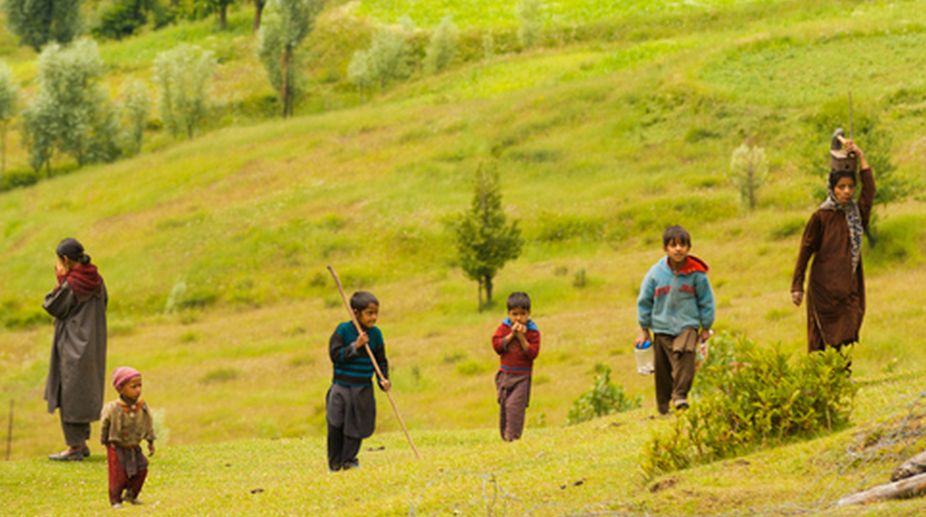For the hardy goatherds of Jammu and Kashmir, called “Bakarwals”, it is time to say goodbye to the mountain pastures of the Valley as autumn sets in.
Each year, the Bakarwals travel more than 700 km on foot across the Pir Panjal range to reach the mountain pastures of the Valley with their sheep, goats, horses, women and children — and minimum household goods.
Advertisement
The journey of the Bakarwal families is a saga of endurance and determination.
These nomadic goatherds trvel to graze their livestock in the high altitude pastures of the Himalayas. Once in the meadows of the Valley, the Bakarwals exude a sense of achievement matched by few.
“The grazing areas of our livestock are marked. The meadow that has traditionally been used for grazing by goats and sheep of one family over generations cannot be encroached upon by any other family,” said Hussain Khatana, 54, the patriarch of a goatherd family.
The goatherd families come to the Valley by the middle of each spring and live on the pastures up to the middle of September.
These families come mostly from Rajouri, Poonch and Reasi districts of the Jammu region, where the summer heat parches the grasslands, leaving little for the survival of the goatherds’ livestock.
The women of these families are as tough as the men.
Small children are carried on the backs of their mothers while the older men and women have the luxury of riding on horseback during the annual two-way migration.
Not surprisingly, even childbirth occurs during such journeys and the eldest woman of the family acts as the midwife for such roadside deliveries.
“Carrying a pregnant lady to hospital for childbirth happens very rarely in our families. Allah has always been benevolent to us.
“The journey continues after a night halt in case there is a childbirth in the family,” said Sharafat Hussain, 45, who comes each year to the Gangabal pasture in north Kashmir’s Ganderbal district with his family and livestock.
The secret of a Bakarwal’s health and well-being lies in his lifestyle. Obesity, high blood pressure, heart ailments, diabetes and other diseases associated with modern-day living are very rare among the goatherds.
“This is despite the fact that they eat a fat-rich diet including butter, ghee, full-fat milk and mutton,” Javaid, a physician in Srinagar, said.
“On an average, each member of the Bakarwal family travels around 700 kilometres during the to-and -fro journey from their winter homes to the high-altitude grazing grounds.
“They are mostly athletically built and the risk of modern-day diseases is minimised by their lifestyle,” he added.
Since these nomadic families travel with their children, the state government has set up mobile schools for them. The male teacher of such a school, ideally belonging to a Bakarwal family himself, travels to the mountain pastures to teach the children.
“Such schools are still an exception and not all our families are covered under this scheme”, said Shahnawaz, 39, a goatherd travelling back with his family to Rajouri.
In the past, the goatherd’s journey would begin at sunrise and halt at sunset.
Because of the heavy traffic on the Jammu-Srinagar national highway, most goatherds now prefer to travel during the lean traffic periods at night.
The most prized possession of a goatherd family are the shepherd dogs that guard the flocks of sheep and goats during grazing and during the night.
The species are fierce watchdogs — those that deter predators like wolves, jackals and even leopards.
The dogs start barking ferociously when they catch the scent of a predator or any other invader. The family is woken by the barking and the predator is forced to retreat.
Little wonder the goatherd depends heavily on the instincts of his watchdog to protect his life and livestock.
After the day’s grazing, the flock of sheep and goats is herded close to the family tents or the pasture hutments constructed of stone, mud and wooden planks.
Since the same family over generations uses the same pasture, the goatherds have constructed mud hutments inside the pastures using planks of wood available in plenty in these areas.
Kerosene lamps and even resinous Deodar (Cedrus) wood sticks are used as lamps during the night.
The women of the goatherd families specialise in identifying non-poisonous herbs and vegetables that grow naturally in Kashmir’s meadows.
These are extensively used as part of the family’s meals during its stay at the pastures.
As a consequence of education and enlightenment, the goatherds now maintain daily hygiene as compared to the past when bathing and washing used to be a fortnightly luxury.
Braving the vagaries of weather and the demands of a lifestyle that is comparable to the toughest survival courses of professional commandos, the existence of the goatherd remains a saga equalled by few other members of the human race.











